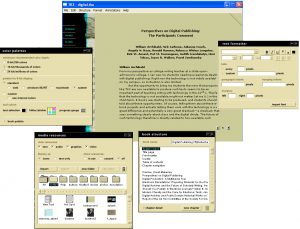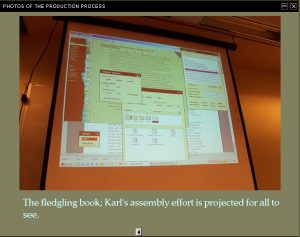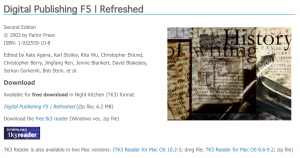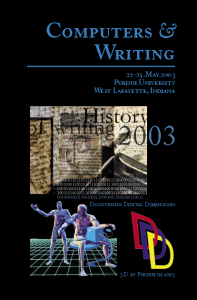Origin Story: Digital Publishing F5 | Refreshed
First, two overtures:
“The flight of our human hours, not really more rapid at any one moment than another, yet oftentimes to our feelings seems more rapid; and this flight startles us like guilty things with a more affecting sense of its rapidity when a distant church-clock strikes in the night-time, or when, upon some solemn summer evening, the sun’s disc, after settling for a minute with farewell horizontal rays, suddenly drops out of sight. The record of our loss in such a case seems to us the first intimation of its possibility. . . .”
—Thomas DeQuincey, “Conversation.” 1847. Selected Essays on Rhetoric. Ed. Frederick Burwick. Carbondale: Southern Illinois UP, 1967. 264.
The Context
The half-day workshop on Thursday, May 22, at Computers and Writing 2003, “Discovering Digital Dimensions,” was titled “The ABCs of Digital Publishing: Portfolios, CDs, Journals, Books.” It promised that “participants [would]be introduced to various technologies for publication and production and have a chance to discuss both theoretical and practical issues related to digital publication.” Participants didn’t know but would discover at the start that we (the eleven facilitators) designed the session as a digital publishing jam, an intense session that would ask everyone to conceptualize, design, write, revise, and publish a real book in record time (three hours). The digital platform would be TK3, a multimedia ebook authoring system created by Bob Stein, a pioneer in digital publishing. Bob was also one of the conference’s keynote speakers and, thankfully as it turned out, one of our eleven facilitators. Twenty-plus participants had signed up. The workshop took place in Purdue’s new Digital Learning Collaboratory in the basement of Morris Library.
The broader context of digital publishing included rapid change in the publishing industry, particularly scholarly publishing, which had experienced precipitous drops in library purchasing (see MLA’s “The Future of Scholarly Publishing,” 2002). As the democratization of production created new opportunities for publishing generally, those opportunities challenged tenure and promotion systems to adapt to the reality of online publication and, for some especially in the humanities, to question the integrity of peer review (see MLA’s response, “Guidelines for Evaluating Work in Digital Humanities and Digital Media,” 2002). Those publishing in online spaces and new media wondered whether extant copyright and intellectual property laws would hinder the conveniences of digital distribution and collaboration, a fear addressed by the formation of Creative Commons in 2001. Ebooks were largely still bound to particular devices and hardware, making standardization of platforms and code anytime soon unlikely and dampening any enthusiasm for building a library of titles. For Bob Stein and many others in computers and writing, the desire to create born digital scholarly work was dampened by overly complex or expensive software that kept authors and creators distant from the means of production.
Preconference Planning
A talented group of graduates students in my “Computers and Writing” seminar planned the workshop: ate Agena, Christopher Berry, Jennie Blankert, Christopher Eklund, Jingfang Ren, Serkan Gorkemli, Karl Stolley, and Rita Wu. They acquired permission for and prepared some of the content that would be included in the book. They also formed the workshop production teams (editorial, design, digital media, production) and in the end were co-editors. We knew that it wouldn’t be possible create (write, compose) the entire book in three hours, so we fortunately we received permission to republish important work on digital publishing from College English, Journal of Electronic Publishing, JAC Online, The Writing Instructor, MLA, the US Copyright Office, and the Society for Cinema Studies. While we planned, the workshop filled up, and arrangements were made for Bob Stein to attend. He would assist Karl Stolley with production during the event itself.
The Production and Reading Software: TK3 Author and TK3 Reader
TK3 Author and Reader were the creation of Bob Stein, longtime advocate and innovator in online publishing circles since its very beginnings in the 1980s. (See Mao, King Kong, and the Future of the Book: Bob Stein in conversation with Dan Visel.”) In “The Real E-Books” (2000, MIT Technology Review), Steve Ditlea highlighted TK3’s focus on authorship and its role in fostering intellectual discourse in new media forms:
A glimmer of tomorrow’s multimedia books, or m-books, may be discerned in a dark-horse contender among e-publishing file formats called TK3. Introduced by Night Kitchen—a New York startup headed by Voyager Co. co-founder Bob Stein—TK3 is the basis for a sophisticated literary software environment. The Night Kitchen TK3 Reader offers the most booklike reading experience on a desktop or laptop computer screen-complete with highlighting, corner-folding bookmarks, even Post-it-like “stickie notes.” And TK3’s easy-to-use multimedia authoring tools are meant, according to Stein, “to empower a new generation of authors who want to express themselves in the new media.” Using this hyperlink-sound-and-motion superset of traditional books to express themselves, such a new generation of authors would hasten Stein’s prediction that “the locus of intellectual discourse will shift from the print medium to the electronic medium.”
Inspired by Stein’s enthusiasm and TK3 Author’s tools for composing, we chose the TK3 format (there weren’t many formats, if any, to choose from at the time anyway). TK3 is actually a precursor in many ways to Apple’s iBooks Author. (Steve Jobs was interested in buying TK3 early on but backed out suddenly.)

Figure 2. The TK3 authoring environment.
The Event
On the day of the event and as Karl Stolley and Bob Stein worked on production and composition of the TK3 book using content already collected, we asked participants what they thought about the future of publishing and its challenges, then gave them time to write, discuss, and revise their work. Meanwhile, the photography and video team interviewed participants and facilitators on video, took pictures, and documented the production process. The goal was to complete the book in three hours (see “Purdue team attempts to write, publish e-book in three hours“). We ran into a few challenges along the way.

Figure 3: The production screen on Karl Stolley’s laptop was projected for all to see. Making the process visible was a key goal.
At three hours, the content for the book was finished. However, we could not locate a long format printer so that we could print and sign all author agreement contracts. Also, our wireless connection was weak (and slow), so that made transferring all the video and images to Karl’s production machine by that method impossible. We eventually found a USB drive and made the transfer (they weren’t nearly so plentiful or large in those days, believe me). Digital Publishing F5 | Refreshed (the title chosen by the group) was finally completed and published to the Parlor Press website in four hours and twelve minutes.

Figure 4. The book’s web page at the Parlor Press website, where readers can still download the book, albeit in formats unlikely to function on most computers these days.
The workshop and publication were covered by the Lafayette newspaper, which capture the excitement and novelty of the moment:, “‘Digital dimensions’ of publishing explored at conference.”
What Participants Wrote about the Future of Digital Publishing
Twelve participants completed their responses for the book. They covered a wide range of topics and possibilities, of course, but some common themes emerged. Most focused on the
Haptic, Material, and Emotional Factors
The most common “obstacle” to the emergence of digital publishing and ebooks was one we still hear today, though less often than back then. eBooks lack the tactile, material, and emotional attachments people have for printed books. As Pat St. Tourangeau put it, “Digital books are fascinating, but they lack the warmth and care of a good book, a warm fire, and a cup of hot cocoa.” Angela M. Haas was rightly skeptical about the claims of many in the rapidly evolving ebook industry:
Although there are researchers that posit that we are evolving into a “post-print” culture, I doubt that the mass consumers agree. Some like the texture, the tactile experience, of reading a print book. Others like the portability. Many like annotating the text in the margins. Even though it appears that digital publishing can offer digitized solutions to such logistical problems as annotations, it cannot replace the print product itself for which many consumers yearn.
In 2003, the battle among ebook vendors for readers was fierce, common standards were nonexistent, the hardware was hard to use, and personal ebook libraries were dependent on the stability of vendors and ebook reader manufacturers. (See Paul Cesarini’s “eBooks: A Battle for Standards,” in The Writing Instructor; this essay was also included in Digital Publishing | F5 Refreshed.) Before the introduction of Amazon’s Kindle, and even then, ebooks were still a long way from satisfying the affective delights of printed books.
Piracy and Copyright
According to Kirk St. Amant in 2003, the ease with which digital products could be replicated and distributed might dampen author enthusiasm for the medium:
Digital publishing faces two key, interrelated challenges in the future. The first has to do with copyright. The electronic nature of digital media means that the replication of materials is a quick, easy, and cheap process. As a result, the difficulties and detriments related to making unapproved copies of a work are very low. Moreover, the incentives to make such copies—either for personal use or for profit—are quite high (especially in developing nations where the mass creation of pirated digital materials is a highly profitable closet industry).
Digital piracy has indeed been a challenge for many, including the textbook industry. However, the problem led to a number of creative solutions. The appearance of Creative Commons licensing in 2001 solved at least one problem and created new opportunities for authors in computers and writing, who were willing to take a chance: publishing under a CC license could make one’s work more widely accessible in a share-alike economy. The WAC Clearinghouse, which has partnered with Parlor Press and others to publish more than forty CC-licensed, open access books, has reported exceptionally high download numbers, especially considering the fairly narrow niche market in rhetoric and composition. (See “Open Access Book Publishing in Writing Studies: a Case Study” by Charles Bazerman, David Blakesley, Mike Palmquist, and David Russell in First Monday, 2008). Writers and artists like Austin Kleon have argued that the replicability and dissemination possibilities of digital media create unique advantages (see Show Your Work: 10 Ways to Share Your Creativity and Get Discovered).
Obsolescence of the Medium
Contributor Pat St. Tourangeau raised an issue that has since been discussed at length by Cheryl Ball and Douglas Eyman: the challenge of creating and sustaining the infrastructures for successful digital publishing. (Ball summarizes these challenges in “Sustainable Infrastructures and the Future of Writing Studies,” WPA: Writing Program Administration 39.1, Fall 2015, 122–137). In “CCDP as a Case Study for Digital Publishing Efforts,” Tim Lockridge, Cynthia Selfe, Melanie Yergeau, Patrick W. Berry and Gail E. Hawisher cite “Sustainability, Labor, and Preservation Efforts” as a major challenge for Computers and Composition Digital Press, requiring much more attention than many anticipated (Blog Carnival 10: The Past, Present, and Future of Digital Publishing). As St. Tourangeau put it in 2003,
I have several concerns with the future of digital publishing. My main worry, I believe, is with the continuity of the medium. How stable is the online environment, for the passage of documents and materials to future generations? Will today’s CD-Rom be yesterday’s 8-track? How will we ensure that documents in an electronic environment will be available in the next millennium?
TK3 Author and Reader weren’t updated after 2004, when the Institute for the Future of the Book, under Bob Stein’s direction, began development of Sophie, the next generation TK3. So in just a few years’ time, the TK3 version of Digital Publishing | F5 Refreshed could only be read on machines running legacy operating systems. Like most complex, multimedia digital projects, this one too needed more attention and maintenance over time than anyone expected, but should have expected. We have a much better understanding of this challenge now than we did in 2003. We’re hopeful that Digital Publishing F5 | Refreshed will reappear in iBook form in March, 2017. Watch for it on the Parlor Press website here.
Hope for the Future of Composing
In my preface to Digital Publishing | F5 Refreshed, I began with this hopeful, perhaps idealistic account of the project:
Our goal was to show that scholars and teachers—when they work collaboratively, have the right technology, and diverse experience with digital publishing technologies—can move to the forefront in publishing, not just as writers, but as publishers, production designers, editors, and (even) distributors. It’s no longer the case, perhaps it never has been, that our creative work needs to be confined to the classroom or the library. We’ve broken the traditional barriers between the academic worlds of scholarship and teaching and—in the midst of globalization and the emergence of Internet technologies—have become major players in the distribution and dissemination economies of publishing.
Looking back from 2016, I see a bit too much enthusiasm for the potential of hardware and software technologies to change deep-seated practices, especially the act of composing. In computers and writing and rhetoric and composition more broadly we have witnessed the rise of scholarly presses and publishers run by scholars and writers in our own field (e.g., The WAC Clearinghouse, Computers and Composition Digital Press, Parlor Press) and the continuing success of open access journals like Enculturation, KB Journal, Present Tense, Harlot, and Kairos. More than any other journal, Kairos has cultivated innovative acts of digital publishing and multimedia composition and collaboration.
In her response, Joyce Walker expressed the desire to explore the compositional possibilities of digital publishing and their impact on the production of knowledge:
My main questions about digital publishing center around how it will change the way we produce knowledge—not only in practical ways, but in how these genres will alter our thinking about the production of academic knowledge. For example, how will work be cited when multiple digital versions exist? How will relationships between authors and readers be changed by these new digital environments? My feeling is that these digital spaces will certainly alter our understanding of who has the power to speak and how.
Pavel Zemliansky saw a future beyond the initial doubts about whether ebooks and digital publishing would precipitate the demise of print:
I think about the true promises of digital publishing: the collaboration, the near-spontaneity combined with almost real-time revision, the multi-genre and multimedia results of such writing and publishing. I also tend to shift my attention from the technological disadvantages of technically imperfect e-readers and palm pilots to new notions of authorship, readership, and the nature of texts themselves. . . . I think that the most exciting promise of digital publishing is the increased and improved collaboration between various writers and even readers. It is the spirit of collaboration and the idea of writing and reading texts together that has been transforming texts, reading, writing, and literacy.
We’re still pursuing the dream of bringing the creator closer to the act of composing complex, multimedia(ted) texts. Nick Carbone recognized that we might have to wait a generation or two before digital natives would realize this potential:
We’ll need a few more generations of scholars, so that students who are now in grade school and learning how to write WWW pages and PowerPoints as part of their courses, and are reading online, often textbooks that K-12 educational publishers are putting on WWW sites, link to self-study guides and self-study quizzes. When these kids get through graduate school, growing as scholars as the e-technologies for writing and reading evolve, we’ll hit a cultural convergence where e-reading and e-publishing meet, and then there will be a market, and a domain, for digital publishing.
I say give it seven to ten years or so.
There’s a well-known saying, attributed to William Gibson, that perhaps suits this kairotic moment at Computers and Writing 2003, when the democratization of production and distribution promised great changes. As explained by Scott Rosenberg in the San Francisco Examiner,
Once whole worlds can be simulated for the senses, the only way to assure the integrity of the public imagination will be to get the power to create those worlds out of the hands of an elite and into general circulation. As William Gibson put it: “The future has arrived — it’s just not evenly distributed yet.” (“Virtual Reality Check Digital Daydreams, Cyberspace Nightmares,” 19 April 1992, page C1)
As Thomas DeQuincey might put it, we have seen the first intimation of digital publishing’s possibility. 2003 seems like yesterday, but we have a long way yet to travel.

